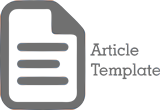Author Guidelines
General requirements
- The length of the article is between 2000-5000 words (Notes, and tables)
- Attach a statement that the article has never been published before, anywhere and in any form.
- Each article will be tested plagiarism using Turnitin where 25% of the articles will be returned to the author
- Component Title: Uppercase, Blue, using Times New Roman letters, size 12
- Sub-subcomponents are not given permaban (except the results and discussion components), but the indications of the sub-components are in the first sentence of a paragraph of that component.
- Articles are presented with the following components:
Title: Article Title Maximum 12 Words Typed With Times New Roman Letters, 14 Bold Print.
Author's name: The author's name is typed under the title with Letter Times New Roman 11 bold, without title and may not be abbreviated. Under the name is written the field of expertise, the name of the institution and the email address of the author.
Abstract: The abstract is typed with Times New Roman font 10, single-spaced, sloping. no more than 250 words, in one paragraph without reference, abbreviations/acronyms, and footnote. Abstracts are written not in mathematical form, questions, and guesses. The abstract contains research objectives, implementation methods, analysis techniques, results of the study, and conclusions.
Keywords: Use words or phrases that specifically describe the contents of the article, keywords separated by commas (,), a maximum of 5 words Author correspondent: describes the full address of the first author along with the full email, listed at the bottom of the right corner of the article (adjust the template)
Introduction: Introduction typed in capital letters [Times New Roman 12 bold] contains the background of overcoming a problem, urgency and rationalization of activities, literature review, problem-solving plan, activity objectives, and hypothesis development [Times New Roman 12 font, normal] Note for Author: The length of the article is between 2500-5000 words (including literature, notes, and tables). Articles are typed in the Microsoft Office Word format. Using Times New Roman font size 12, single space on A4 paper [Times New Roman 12 font, normal]
Method: The research method explains the implementation methods employed in the study. The method is described clearly and in detail [Times New Roman 12 font, normal]
Results and Discussion: Explain the results of the research in the form of problem-solving analyzed using relevant theories. The results of the study also revealed the findings of the research. Discussion is accompanied by logical arguments by linking the results of research with theory, the results of other studies.
Conclusions and Suggestions: Conclusions contain a summary of the results of the research and discussion. Conclusions are research findings in the form of answers to the formulation of research problems or research objectives and research hypotheses. Conclusions are explained briefly and clearly. The suggestion section describes the application or development of science. Conclusions and suggestions do not use points or numbering but are described in one paragraph. [Times New Roman 12 font, normal]
Acknowledgments: Describe anyone who directly helps your research such as funders (an institution called non-personal), may be supplemented by the research contract number. Thank you to the intended parties (if any and significant related to the study).
Reference List: Contains primary literature sourced from national and international journals, books and secondary sources from credible and accountable internet sources. The reference list is written following the American Psychological Association (APA) Fifth edition. All sources listed in the bibliography must be in the article script by using referral applications.
*Review Article
Review article is different from research article. It rather examines data presented by research articles. Review article must be strong in argumentation presented. An argumentation usually contains Assertion which is the claim of statement, reasoning is the logical explanation that supports the claim, warrant is the soul of the argument that covers the question “so what?”, and evidence is the last part that strengthens the reason.
The structure of your review article includes abstract, introduction, body, conclusion, and references.
*Abstract: typed with Times New Roman font 10, sloping, no reference, nor abbreviation/acronym and footnote. It generally includes a summary of the review question, the primary study reviewed and conclusions of the study.
*Introduction: write the topic of the study, which serves as the identification sentence. It should indicate what the article contains. Clearly outline the order in which every sub-topic will be discussed to give the reader background information needed to understand the sections in the article.
*Body: including subtopics the study addresses.
*Conclusion: it should briefly state your rationale for your review and the purpose of the article.
*References: using APA fifth edition style.








